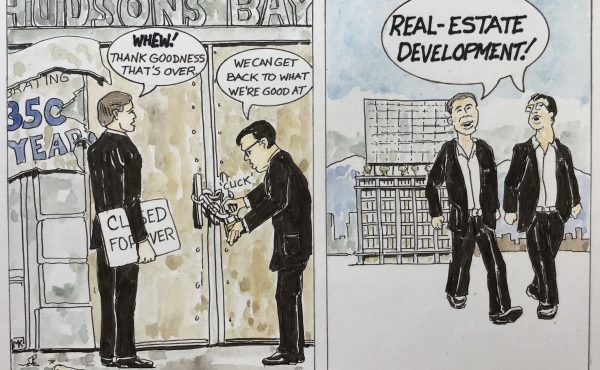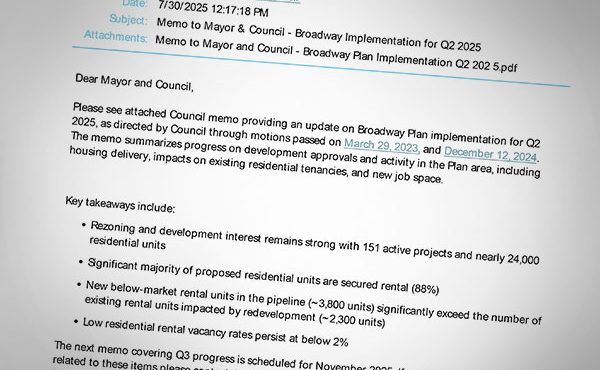 By Sean Ruthen, re:place magazine
By Sean Ruthen, re:place magazine
Photos by Barbara Stewart
The first weekend of May this year offered Vancouver a number of activities to indulge in – a marathon, a political debate, a playoff game. For some however, it was a weekend to remember a civic hero who, for the third year in a row, has continued to inspire thousands to put on their walking shoes and go for a stroll through their city’s streets. A little over a year after Jane Jacobs’ passing in 2006, residents of both Toronto and New York improvised walking tours through their local communities to honour their lost Virgil, i.e. guide of the divine comedy that is our modern city.
Since then, the number of cities participating in ‘Jane’s Walk’ has grown to 45, with this year including even Mumbai, so far has her urban vision extended. Toronto, New York, Ottawa, Calgary, Edmonton, Vancouver, Winnipeg, Halifax, Guelph, Charlottetown, Thornbury, and Salt Lake City participated in 2008, while this year Montreal, Regina, Boston, Chicago and New Orleans were among the new participants. With an astonishing 27 tours offered in Vancouver alone over two days, one can only imagine the thousands of people across North America that went outside this Spring weekend, not just for the fresh air and exercise, but to celebrate something that Jane would’ve called community spirit.
And community spirit is certainly what was found, as in one case a tour guide who failed to show up was replaced by someone that had shown up for the walk – these were definitely what I would call ‘Jane’s folks’. My first experience with this community spirit was on last year’s walks, in which I was able to go on two individual tours offered by Kera McArthur and Bruce MacDonald (you can read the story here). While Bruce is well known for his book Vancouver: A Visual History (1992), Kera is a member of Think City, the local non-profit organization that has put on Jane’s Walks in Vancouver now for the last two years (for full coverage of the event visit their website).
Among the numbers of participants who signed up for walks this year (a smaller number of tours from the previous year were offered for a 20% larger turnout this time around), it was the participation of the tour guides that was key to the event, as all were volunteers offering their own unique viewpoint of their respective neighbourhoods. Tour guides from last year that returned again this year included John Atkin, Gordon Price, as well as the already mentioned Bruce MacDonald. Wendy Pedersen did her walk though the DTES again, and the (clothed) Wreck Beach walk returned. While it is unfortunate that the limited number of daylight hours in two days invariably leaves only 4 to 6 opportunities to go on any of the 27 walks, it is an amazing demonstration of civic pride that so many have returned again at this time of year to remember Jane, by learning something about their community, or passing on an increment of wisdom about it.
 Having enjoyed myself so much on Jane’s Walk last year, I decided to try a different perspective this year, and volunteered to offer a tour of my own. Actually, the tours are everyone’s – as any oral tradition is – as I first encountered my collection of civic lore during the Summer of 2000 when I led six architectural walking tours, five days a week, for the AIBC. The Central Business District walk I offered for the two dozen people who signed up was an amalgam of that old AIBC walk I used to give with nine years of new building fabric stitched into it – including the Bentall 5 and One Wall Centre.
Having enjoyed myself so much on Jane’s Walk last year, I decided to try a different perspective this year, and volunteered to offer a tour of my own. Actually, the tours are everyone’s – as any oral tradition is – as I first encountered my collection of civic lore during the Summer of 2000 when I led six architectural walking tours, five days a week, for the AIBC. The Central Business District walk I offered for the two dozen people who signed up was an amalgam of that old AIBC walk I used to give with nine years of new building fabric stitched into it – including the Bentall 5 and One Wall Centre.
I must again thank the assistant that Think City provided me for my walk, as well as for every other tour guide – something new this year – as this assitant took a staggering 70 pictures during the walk, available to view on flicker from the Think City website (close to nine hundred at last count). As a pedestrian calling the CBD home (the office I work in is Erickson’s wonderfully terracing Evergreen building in Coal Harbour), I felt it apt to give a walk in an area which Jane would’ve agreed is vital to any city – its financial district – thus taking the group past the bank towers, as well as the Marine, Guinness, and Bentall towers, pointing out the strange urban pairing of the Christ Church Cathedral with the gargantuan Park Place (with its curious address of 666 Burrard Street).
Other highlights of the tour featured the Cathedral Place tower replacing the Georgia Medical Dental building, with its stone nurses anchoring each of its corners. Some of the newer tour-goers may not have known the HMV at the corner of Burrard and Robson used to be home to the main branch of the VPL, or that the Electra used to be the BC Electric Company building. But having started the tour at Waterfront Station, regaling the history of how the CPR’s arrival would overnight transform the small sawmill town, it was only a few flights of stairs to Granville Square where, unbeknownst to most folks looking out over the Burrard Inlet to north shore mountains, they were standing at the deck level of what would have been a fifty meter wide elevated freeway that was to run along the waterfront, proposed in the 1960’s and known as the Gastown 200 Project.
With the Georgia Viaduct representing the only part of the project actually built for automobiles, the tower at Granville Square represents the type of building that the then planners envisioned marching along the waters edge, replacing the then rundown warehouses along Water Street that we now call Gastown. It was in Vancouver’s history at precisely this moment that Jane’s folks rose up, much as they had in both Toronto and NYC when those cities had tried to build freeways through equally loved neighbourhoods. The result is that instead of a noisy eyesore of a freeway on the waterfront, as both Toronto and Seattle have, Vancouver has Gastown and one of the most walkable downtowns in all of North America, for which we all have Jane Jacobs to thank.
With the CBC and Georgia Strait among the event’s supporters, Think City has spear-headed an event in the Lower Mainland that is simultaneously both global and local. Perhaps nothing at this moment in history could be more vital to the regeneration of our communities than an event to bring so many like-minded people together – not unlike the Canucks’ fans or the running enthusiasts with the Vancouver Marathon (which one Think City organizer pointed out to me will always fall on the same weekend, as the event is held on Jane’s birthday).
As Think City put on their website during the run-up to the walks, quoting Jane herself: “no one can find what will work for our cities… by looking at suburban garden cities, manipulating scale models, or inventing dream cities. You‘ve got to get out and walk.” With the world seeming to have reached all at once its present critical mass, both economical and ecological, it would seem that people are turning to their immediate environments to ask themselves what kind of product it is that they have become. And what better way to discover this than to start with one’s feet firmly planted on the ground.
Hearing the stories, whether from a member of Think City or Ned Jacobs – Jane’s son who was in Vancouver for the event – the display of so many communities participating in Jane’s Walks is I think proof that the human spirit will prevail over such uncertain times. And unlike the economy or the weather, we are in control of the destinies of our cities, of both their death and their life as Jane pointed out. It was in her last book however, Dark Age Ahead, where she warned us, much like the tragic prophetess Cassandra warned her fellow Trojans of the fall of their great city, of our present economic cataclysm, as well as providing us with a sober reminder of how bad things still could get, as she recalled how during the Great Depression (she was nineteen at the time) that unemployment reached an unthinkable 25%.
Most importantly however, Jane Jacobs reminds us, as I’m sure many of the tour guides this weekend most certainly would’ve, that it is a community that builds its city, and not the other way around.
Thank you Citizen Jane!
***
Sean Ruthen is an intern architect working, living, and writing in Vancouver.



